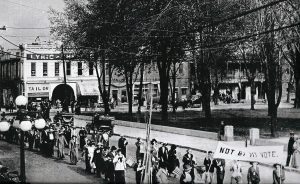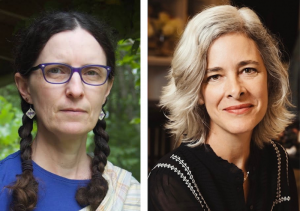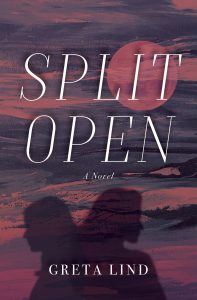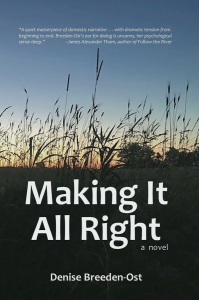On Jan. 13 … more than a dozen mothers met on the 50-yard line of a local football field. [One] opened the event with a greeting and prompted the women to check in with how their stress felt in their bodies. Then, they screamed.
For [one mother], it was exactly what she didn’t know she needed. “It felt good to be able to be out of control,” she said. “We have been holding this tight leash on everything we could possibly control during these two years.” … [Another] put it: “We as women have carried so much of the load, and we are allowed to be mad.” –Washington Post, February 15, 2022
Can a woman have it all — professional or creative fulfillment and a family life?
Is the question really still relevant? After all, it’s been 174 years since the Seneca Falls Convention, 102 years since the 19th Amendment gave us the right to vote, 49 years since Roe v. Wade said we were in charge of our bodies, 48 since the Equal Credit Opportunity Act entrusted us with money, and already 29 years since the Family and Medical Leave Act gave some of us the right to take 12 whole, unpaid weeks off after giving birth to or adopting a child without losing our job.

A suffrage parade in early 1900s in downtown Sullivan, Indiana. | Photo courtesy of the Sullivan County Historical Society
So we’re in good shape, right? Of course a woman can have it all. (Provided she is white, cisgender, and checks all kinds of other privilege boxes.) In that case, she has access to all the professional opportunities a man has. And, if she has a family, all the domestic responsibilities she has always had. Because (even though many earnest millennials of a certain socioeconomic class will protest that there is an equitable, non-gendered division of labor in their home) when push comes to shove, it’s much more often the woman who steps in as shock absorber.
Witness the last two years. At the start of 2022, there were nearly 1.1 million fewer women in the labor force than in February 2020 (according to the National Women’s Law Center), with Black and Latina women even more disproportionately affected. Our mass exodus from the workforce correlates with the longstanding inequities that have restricted women to the kinds of jobs first taken out by COVID, the lack of policy and infrastructure supporting the needs of families, and the cultural norms that have relegated women to the home front, even if they work outside of the home. Even before COVID, according to a 2020 UN report, women across the world were spending three times as many hours as men in unpaid care and domestic work. Meaning “work-life balance” is one more thing for women to do.
In 2020 that cute expression broke for good. For parents (and statistically more often than not, moms) the daily calculus of trying to get a school day that ends at 3 to match up with a workday that ends at 5 (or midnight or 6 a.m. depending on your shift) was bush-league in comparison with trying to work when there’s no school or daycare. “With the spread of the COVID-19 pandemic,” the UN reported, “even the limited gains made [toward gender equality] in the past decades are at risk of being rolled back.”
It is perhaps not surprising, then, that at this moment in history, with our rights at risk of being rolled back decades, we witness the publication of two novels by women freshly examining that shopworn question: Can a woman have it all?

The debut novels by Indiana authors Denise Breeden-Ost (left) and Greta Lind are “deceptively conventional,” writes Yaël Ksander. | Courtesy photos
Debut novels by two Indiana authors address that question by transporting us to a fictive space either preceding or somehow sheltered from the culture wars that have surrounded it since the 1960s. Denise Breeden-Ost’s Making It All Right (Clockflower Press, 2020) and Greta Lind’s Split Open (Pond Reads Press, 2021) each situates us inside the life of a wife and mother who is smashing up against the “problem that has no name” — Betty Friedan’s diagnosis for unfulfilled white, hetero, middle-class housewives in 1963. Sixty years later, returning to that problem might seem like the stuff of science fiction. Then again, so does the increasingly common spectacle of stay-at-home moms meeting to scream in a field. Deceptively conventional, these novels fly under the book-banners’ radar to deliver their own form of rebellion.
Lind’s and Breeden-Ost’s protagonists do not work outside of the home, complicating their efforts to protect what’s theirs within it. When you don’t have an office to go to, or at least the proverbial room of one’s own, the nebulous, never-resolved nature of the domestic sphere is enough to make you forget what’s yours. Each protagonist, however, is a latent artist — Breeden-Ost’s May tends to “tinker” and Lind’s Kate is starting to write. In different ways, both May and Kate harness their creative powers to resolve the conflict between family needs and self-actualization. And although neither novel is science fiction, in each case, the solution involves a doppelgänger. In other words, to be a woman in full, you’ve got to be crafty, and you might have to lead a double life.
When we both had young kids, another mom — who was also a wife and working artist — used to tell me, “I’m going to hire an actress to play me, so that between us we can cover all the bases.” I enjoyed the giddy mischief of her suggestion, but heard a note of sadness too. Because implicit in the cloning scheme is an acknowledgment that one woman still can’t have it all, as the U.S. State Department’s first woman director of policy planning conceded after resigning from that post in 2011. Far from Washington, and high-powered jobs, Lind’s and Breeden-Ost’s domestic tableaux give us the time and space to consider the question anew.
“I’m afraid the right thing for everyone else is not the right thing for me,” admits the wife and mother at the center of Lind’s novel. “How do I deal with that?” It’s a problem we can glibly dismiss as obsolete, more pressing for our mothers or grandmothers if they bucked against the societal expectations of their time. But how many of us have found ourselves at that fork in the road, having to make a choice for ourselves that shortchanges our family time, or vice versa, consequently enduring contempt from the outside world — or internalizing it?
 Set in Ojai, California, and Evanston, Illinois, in the approximate present, Split Open unfolds in a rarefied sphere of cafes, galleries, therapy sessions, and midday rendezvous that might make some of us want to quit our jobs. But Lind’s well-observed accounts of the torpor of stay-at-home motherhood snap us out of our envy: This is the land of sorting socks, uninspired cooking, and “post-field-trip exhaustion.” When the book gets adapted for TV (to which it lends itself), they should use Lisa Germano’s song “Bruises” to set the mood: “Coffee in the morning/And wine in the evening/And everything else is boring, boring.” No one is pretending to be a domestic goddess around here. We feel as though we are reading instructions off a cardboard box as Lind’s disaffected women go through the motions of preparing a meal: “break an egg, add ground turkey … top it off with ketchup.” Forget Friedan, this is the world that even Julia Child forgot. The midcentury staples served up here — meatloaf, mix brownies, microwave popcorn — originally promised to give women back more time. So how’s that working out?
Set in Ojai, California, and Evanston, Illinois, in the approximate present, Split Open unfolds in a rarefied sphere of cafes, galleries, therapy sessions, and midday rendezvous that might make some of us want to quit our jobs. But Lind’s well-observed accounts of the torpor of stay-at-home motherhood snap us out of our envy: This is the land of sorting socks, uninspired cooking, and “post-field-trip exhaustion.” When the book gets adapted for TV (to which it lends itself), they should use Lisa Germano’s song “Bruises” to set the mood: “Coffee in the morning/And wine in the evening/And everything else is boring, boring.” No one is pretending to be a domestic goddess around here. We feel as though we are reading instructions off a cardboard box as Lind’s disaffected women go through the motions of preparing a meal: “break an egg, add ground turkey … top it off with ketchup.” Forget Friedan, this is the world that even Julia Child forgot. The midcentury staples served up here — meatloaf, mix brownies, microwave popcorn — originally promised to give women back more time. So how’s that working out?
For all the time she saves by preparing convenience foods, Lind’s Kate is nonetheless circling in a holding pattern drawn by traditional gender roles and expectations. A professional writer, Kate’s husband, David, swoops in and out of family life, too tired to follow through on a Saturday hike with their sons after turning in too late. “You have no idea how much I cover for you,” she tells him, once her frustration with his increasingly distant behavior lands them in the therapist’s office. An aspiring writer herself, Kate struggles against her husband’s unavailability for caregiving to carve out the time for her own creative work.
But Kate’s persistent internal monologue shows us how much she also struggles to give herself permission to come into her own. Raised by a mother she refers to as “traumatized,” Kate compensates by granting her kids complete access to her. She can’t quite summon the nerve to give them the occasional “shush, I’m working,” like Joan Didion frequently told her daughter. But Didion was later haunted by her need to protect her creative practice, while Kurt Vonnegut’s tendency to storm out of his home office bellowing at the kids to “shut up” is a laugh line in a recent documentary about him. A mother without borders, Kate is reluctant to do the solo journeying her craft demands. “I worry about the boys. When I write … I go somewhere else.”
Magically, the limitations she’s felt since marrying and having children are irreparably “split open” when Kate turns superhero on an ordinary field trip. In stopping a runaway school bus, Kate manifests a side of herself she didn’t know she possessed, prompting a series of courageous actions: moving the family across the country, attending a spiritual workshop, and creating a fictional alter ego. The mitosis that produces this sister act proves ultimately to restore Kate’s own sense of wholeness: “I’m done with Jennifer’s story,” Kate tells her therapist, “and now, finally, I am ready to write my own.”
Like Kate, the woman at the center of Breeden-Ost’s Making It All Right is a creative type. But May doesn’t have to invent an imaginary twin — her foil is flesh and blood. For May, like Kate, creativity is key to devising a plan whereby she can have her family and keep something for herself. It’s a proposition that didn’t exactly have cultural currency in rural Indiana in the late ’40s, the era in which Breeden-Ost has with scrupulous continuity set the novel. So May’s bravery and ingenuity in “making it all right” is that much more transgressive.
 But some things never change. Like meatloaf, for example (which might just be Lady Code for a lot of pent-up feelings). Yes, there’s a meatloaf-making scene in this book too — but the egg for it was just laid in the coop, the carrots just pulled from the garden, and three women are working together in the kitchen. Breeden-Ost’s descriptions of the relentlessness of a farm wife’s responsibilities leave you bone tired and somehow appreciating tacky convenience foods in a whole new way. On top of her own job — where of course every day is Bring-Your-Child-to-Work Day — May (like Lind’s Kate in another galaxy far, far away) spends a lot of time covering for her husband, Hal. In other words, as the old adage goes, “Man works from sun to sun/But woman’s work is never done.” Breeden-Ost makes women’s invisible labor of compensating for men’s absence palpable. “Feeding a crew [of men],” for example, feels more tiring than the chore should be, May notes, “as if the noise and size and smell of the men was work in itself.” Descriptions like that one shine a light on a husband’s inability to show up, calling out the negative space for the burden that it is.
But some things never change. Like meatloaf, for example (which might just be Lady Code for a lot of pent-up feelings). Yes, there’s a meatloaf-making scene in this book too — but the egg for it was just laid in the coop, the carrots just pulled from the garden, and three women are working together in the kitchen. Breeden-Ost’s descriptions of the relentlessness of a farm wife’s responsibilities leave you bone tired and somehow appreciating tacky convenience foods in a whole new way. On top of her own job — where of course every day is Bring-Your-Child-to-Work Day — May (like Lind’s Kate in another galaxy far, far away) spends a lot of time covering for her husband, Hal. In other words, as the old adage goes, “Man works from sun to sun/But woman’s work is never done.” Breeden-Ost makes women’s invisible labor of compensating for men’s absence palpable. “Feeding a crew [of men],” for example, feels more tiring than the chore should be, May notes, “as if the noise and size and smell of the men was work in itself.” Descriptions like that one shine a light on a husband’s inability to show up, calling out the negative space for the burden that it is.
And this burden is a little heavier than most. May’s capacity for doing all of the couple’s emotional work gets turbocharged when Hal (who — déjà vu! — has grown distant) reveals he’s in love with another woman. Having fixed all kinds of things around the farmstead, May fixes this one too. And daring to propose that a woman can in fact have it all is only the start of what makes her solution transgressive. They say that many hands make light work, and there are aspects to the arrangement that come as a relief, but as it turns out, welcoming Hal’s mistress into the household only adds to the weight of May’s invisible labor. We feel the pressure build every time a relative throws shade or Hal shows his ass. (Which is the whole time.) Instead of letting off steam, Breeden-Ost’s pressure cooker of a novel captures exactly how much a woman has to endure in an attempt to have it all.
In this provincial world of canning fruit and churning butter, it’s easy to forget that we’re not on the prairie with Laura Ingalls but just down the road from Bloomington, at the time when Alfred Kinsey was conducting his inquiries into human sexuality. Although it is not acknowledged by the characters, the first Kinsey Report would have been published by the time the novel’s action takes place, somewhere in southeastern Indiana. The irony of that juxtaposition stings like the discovery of a captive under a tarp in a neighbor’s backyard. May’s unconventional gender identity and actions make us long that somewhere in between the Farm Journal and the Jack Benny Show, news of Kinsey’s work would have made its way to the farm. Playing the alpha role in the family — tall, “with her man’s shoulders” — May chops her hair, puts on trousers, and works with the men in the tobacco field. And most improbably, without knowledge of any cultural precedent beyond a whisper of Mormonism, she curates a polyamorous ménage.
One can only imagine how these sexual shenanigans in the hinterlands would have enriched the Kinsey Reports, and how access to that bestseller could in turn have empowered May. Instead, May never quite accepts herself for not being “little and cheerful, like Vera,” and her sexual revolution is short-lived. Her ability to sustain the experiment or to envision a life away from “that useless man I’d married” is limited by her times. Her acknowledgment that “now that the war was over, nobody wanted a woman who could use a wrench” reminds us how particularly stagnant the post-war years were with regard to women’s advancement. As May slowly resigns herself to a more conventional marriage with Hal, Vera (the mistress) sets off for sophisticated Bloomington, where we get to peek into her happy life with roommates. Whether Vera ends up participating in Kinsey’s interviews for his women’s report, which would be published in 1953, we can only wish.
To have it all, these new novels suggest, a woman might have to live a double life. And who’s to say whether you or your doppelgänger gets to run off to town — you might end up being the one who has to keep the home fires burning instead. These two contemporary takes on domestic fiction remind us that it’s still a fantasy.
[Publisher’s note: This article was underwritten by Morgenstern Books. Located at 849 S. Auto Mall Rd. in Bloomington, Morgenstern’s is Indiana’s largest independent bookstore.]
Denise Breeden-Ost and Greta Lind will read from and discuss their work with Yaël Ksander at Morgenstern Books on Monday, March 7, from 6:30 to 7:30 p.m. The event is free and open to the public. This author talk is cohosted by Morgenstern Books and Limestone Post. Learn more on the Facebook event page.
 Listen to a recorded version of this review by Yaël Ksander on Inner States, a weekly show on WFIU Public Radio “about art, culture, and how it all feels, in Southern Indiana and beyond.” Inner States can be heard on WFIU on Sundays at noon, and afterward on the Inner States podcast. Limestone Post and Inner States have partnered to promote work by local and regional writers across platforms.
Listen to a recorded version of this review by Yaël Ksander on Inner States, a weekly show on WFIU Public Radio “about art, culture, and how it all feels, in Southern Indiana and beyond.” Inner States can be heard on WFIU on Sundays at noon, and afterward on the Inner States podcast. Limestone Post and Inner States have partnered to promote work by local and regional writers across platforms.



